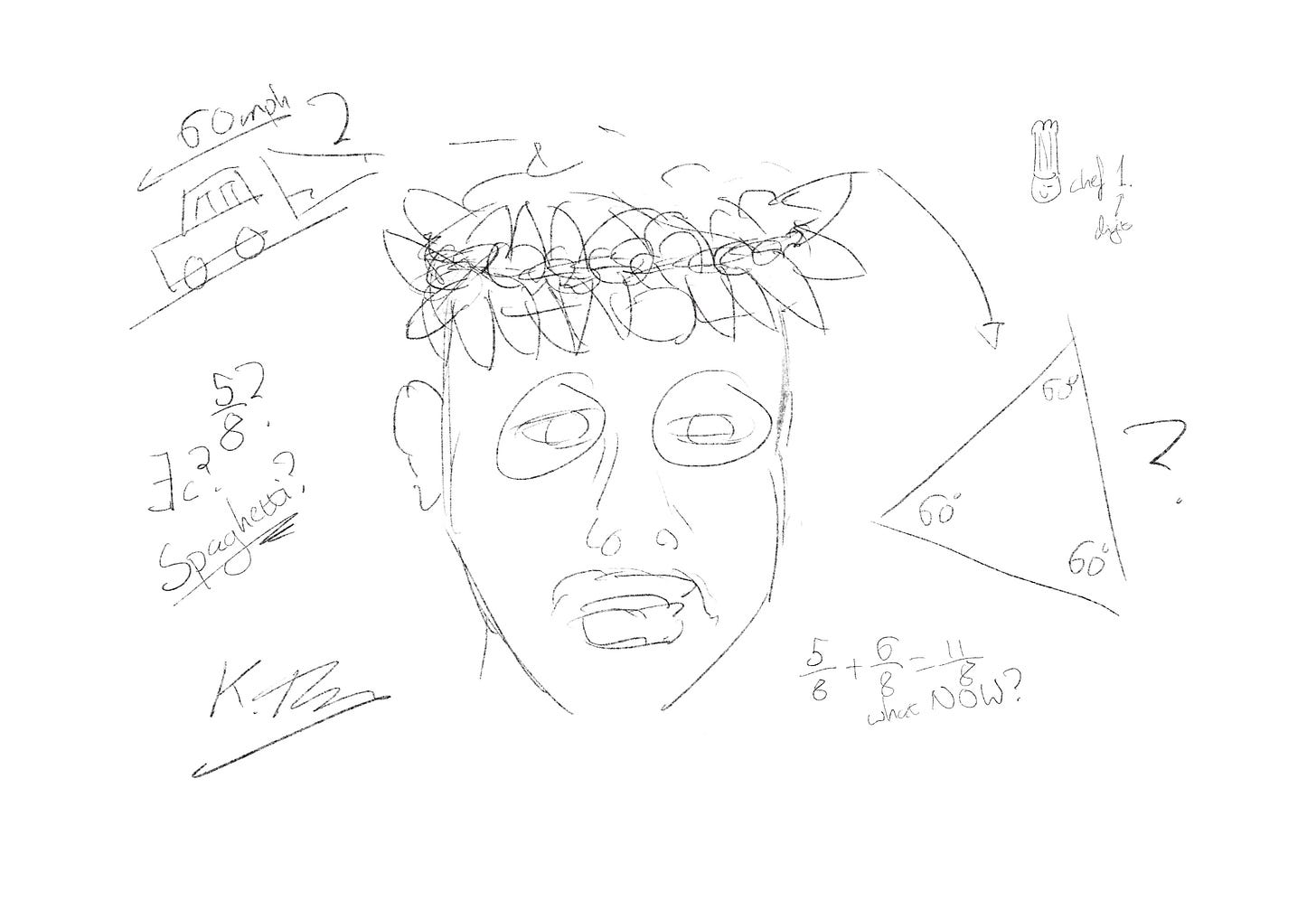What is 'one'? And the Joy of Humility
Dear Reader,
This week, I assumed that school-level maths was beneath me. I got stuck on the first question and couldn’t even use fractions. It helped me to relearn the value and joy of humility.
After flying through the previous week on the momentum of having passed the SSCP exam, I consulted my new OSSU Computer Science curriculum with glee. ‘Systematic Program Design’, ‘Class-based Program Design’, ‘Programming Languages, Part A–C’, the list continues. The only prerequisite is ‘Pre-College Math’. No problem: I did GCSE Maths and Further Maths, and I sat in on some A-Level lessons.
Pre-College Math: Algebra, Geometry, Trigonometry, etc. Try the final tests and go over any gaps. Cool.
One chef makes 5/8 of a pound of spaghetti every hour, while another chef makes 3/4 of a pound of spaghetti every hour. If these chefs work together, how long will it take them to make 8/9 of a pound of spaghetti?
To give you an idea of how I fared, here is my ‘answer’ page:
My mathematical mind, resting slothfully on its GCSE-certificate laurels, was suddenly plunged into the ice water of secondary school memes.
If a car is travelling at 60 mph with three passengers, the speed of light is a thing which exists, and Pedro throws an equilateral triangle out of the window, how tall is my dog?
I assumed that the school-level maths would be easy—beneath me, even—but I couldn’t even remember how to solve fractions. I managed to get about halfway but it wasn’t until my extremely patient friend, studying PhD Mathematics at the University of Cambridge, explained it to me step-by-step that I finally understood the answer. I felt humbled by the experience, swallowed my pride, and followed the OSSU’s advice by beginning again with ‘Arithmetic #1: Introduction to Numbers’.
In 1946, my Nana was four years old in a small classroom somewhere in England, learning about the number line. When the teacher introduced the symbol ‘1’, called ‘one’, Nana asked, ‘what is one?’
Unfortunately, her teacher scolded her for being naughty. Apparently, questions are disruptive in a classroom. Unfortunately for her teacher—or rather, fortunately for any teacher worth their salt—Nana was an insatiably curious person.
Seventy-nine years later as I sat, pencil in hand and notebook at the ready, watching a number line apparate on the glowing rectangle before me, I had the exact same question.
‘Now, you might ask what numbers are’, says my YouTube tutor.
‘Yes’, I think.
‘I don’t know. I’m not sure whether anyone knows, but this is how we write them’, he says.
‘Damn’, I think.
What followed was the most interesting recap of mathematical rudiments I’ve ever encountered. To be fair, it’s probably the only detailed recap of mathematical rudiments I’ve ever encountered, and the content wasn’t particularly novel:
‘Digits’ are individual symbols used to represent numbers.
‘Numerals’ are written combinations of digits.
‘Positional notation’, or ‘place value’, is a numeral system whereby numerical value is represented by digits and their places in relation to one another.
We write numbers in ‘word form’—e.g. ‘one, two, three’—and ‘standard form’—e.g. ‘1, 2, 3’.
‘Inequality’ is represented by the ‘lesser-than’ and ‘greater-than’ symbols: ‘<’ and ‘>’, respectively. The crocodile eats the bigger number.
The equals sign, ‘=’, is also a thing.
To me, the most interesting part wasn’t so much the content but rather the perspective with which I approached it. For instance, we use ten digits, ‘0–9’, perhaps because we tend to have ten fingers to count with, but what if we only had two, like binary numbers, or eighteen?
What about Braille?
Would I be thinking about the same numbers if I were reading and writing them using a different numeral system?
What is ‘one’?
By practising humility and returning to the very basics with an open mind, I indeed recapped school-level maths, but I left with a deeper understanding and a richer conceptual context. I left with questions I’ve barely thought about and can hardly answer. I’m excited to learn about addition and subtraction this week.
If you think you know something, I encourage you to try explaining it as simply as you can. You might be surprised.
Thank you for your attention.
Kind regards,
Kai Tebay



